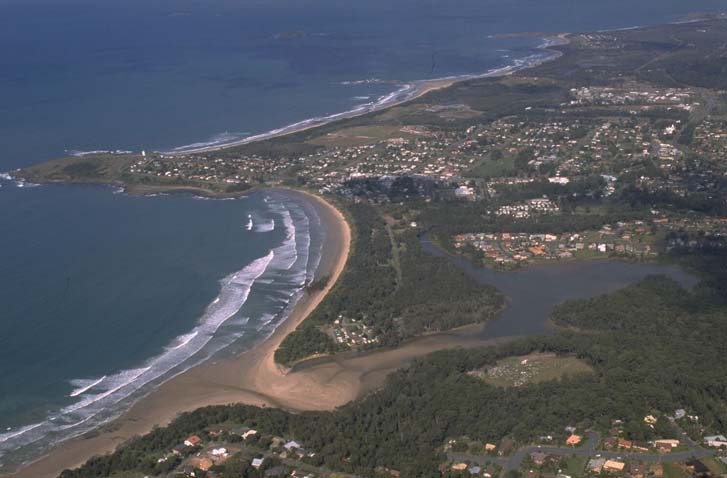Woolgoolga Lake estuary is situated in Woolgoolga on the north coast of New South Wales. It is classed as a lagoon with an intermittently closed/open entrance. The estuary is surrounded by urban development.
Water quality report card
As part of our water quality monitoring program we assess the water quality and ecosystem health of an estuary using a range of relevant indicators. We sample a subset of the estuaries located between the Queensland border and Taree every 3 years. The most recent sampling in Woolgoolga Lake was completed over the 2021–22 summer, when 2 sites were sampled on a monthly basis.
This report card represents 2 water quality indicators that we routinely measure: the amount of algae present and water clarity. Low levels of these 2 indicators equate with good water quality.
The report card shows the condition of the estuary was excellent with:
- algae abundance graded excellent (A)
- water clarity graded good (B)
- overall estuary health graded excellent (A).
Grades for algae, water clarity and overall are represented as:
- A – excellent
- B – good
- C – fair
- D – poor
- E – very poor.
Coffs Harbour City Council, in collaboration with the University of New England’s EcoHealth program, has carried out detailed ecosystem health monitoring in Woolgoolga Lake. The results of the monitoring program, including a detailed water quality report card, are available on the Coffs Harbour City Council website.
Go to estuary report cards to find out what each grade means, read our sampling, data analysis and reporting protocols, and find out how we calculate these grades.
We have monitored water quality in Woolgoolga Lake since 2009. This table shows the water quality grades for this estuary over that time.
| Year | Algae | Water clarity | Overall grade |
|---|---|---|---|
| 2009–10 | B | D | C |
| 2012–13 | A | A | A |
| 2015–16 | B | B | B |
| 2017–18 | B | C | C |
Physical characteristics
| Estuary type | Lagoon |
|---|---|
| Latitude | –30.1 (ºS) |
| Longitude | 153.2 (ºE) |
| Catchment area | 21 km2 |
| Estuary area | 0.2 km2 |
| Estuary volume | 67 ML |
| Average depth | 0.4 m |
Notes: km2 = square kilometres; m = metres; ML = megalitres.
Water depth and survey data
Bathymetric and coastal topography data for this estuary are available in our data portal.
Land use
The catchment of Woolgoolga Lake is highly disturbed. Urban areas around Woolgoolga and grazing/horticulture each occupy about 20% of the catchment. Over half of the catchment, especially in the upper reaches, remains forested and managed by NSW National Parks and Wildlife Service and the Forestry Corporation.
National and marine parks
- The largest conservation area in the Woolgoolga Lake catchment is Sherwood Nature Reserve.
- Coffs Coast Regional Park is located on the northern side of the estuary mouth.
- Woolgoolga Lake is part of the Solitary Islands Marine Park.
Community involvement
- Coffs Harbour Regional Landcare provides workshops and volunteer work opportunities along the Coffs Coast.
- There are 22 bushcare and landcare groups in the Coffs Harbour area, including in Woolgoolga. These groups mainly work within the Coffs Coast Regional Park. For more information go to the National Parks and Wildlife Service Coffs Harbour bushcare and landcare webpage.
Local government management
Local councils manage estuaries within their area unless the estuary is attached to a marine park.
Woolgoolga Lake estuary is managed Coffs Harbour City Council and the NSW Department of Primary Industries and Regional Development as part of the Solitary Islands Marine Park. Information about this estuary can be found on the Council’s Woolgoolga Lake webpage.
Threatened species
Threatened species such as the grey-headed flying-fox are found within the Woolgoolga Lake catchment. Grey-headed flying foxes have established a large camp on the edge of the lake.
Read more about the biodiversity in our estuaries.
